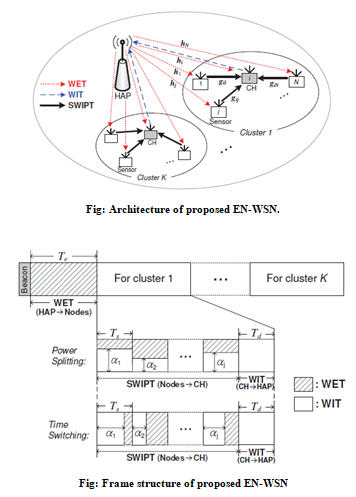Energy-Neutral Wireless Sensor Network Based on SWIPT in Wireless Powered Communication Networks
Objective
To maximize the achievable rate of sensing data while guaranteeing ENO, we propose a novel ENO framework, which provides a frame structure for SWIPT operation, rate improvement subject to ENO, SWIPT ratio optimization, as well as clustering and CH selection algorithm.
Abstract
In this project, we introduce a novel ENO framework. For energy-neutral operation (ENO) of wireless sensor networks (WSNs), we consider a WSN deployed in a wireless powered communication network. In this network, sensor nodes with high harvesting energies and good link budgets have energy remaining after sending their data to the cluster head (CH), whereas the CH suffers from energy scarcity.
Thus, we apply the simultaneous wireless information and power transfer (SWIPT) technique so that the sensor nodes can transfer their remaining energy to the CH while transmitting data in a cooperative manner. To maximize the achievable rate of sensing data.
While guaranteeing ENO, we propose an ENO framework, which provides a frame structure for SWIPT operation, rate improvement subject to ENO, SWIPT ratio optimization, as well as clustering and CH selection algorithm.
Keywords: Wireless sensor network, energy-neutral operation
NOTE: Without the concern of our team, please don't submit to the college. This Abstract varies based on student requirements.
Block Diagram

Specifications
Software & Hardware Requirements:
Software: Matlab 2018a or above
Hardware:
Operating Systems:
Windows 10
Windows 7 Service Pack 1
Windows Server 2019
Windows Server 2016
Processors:
Minimum: Any Intel or AMD x86-64 processor
Recommended: Any Intel or AMD x86-64 processor with four logical cores and AVX2 instruction set support
Disk:
Minimum: 2.9 GB of HDD space for MATLAB only, 5-8 GB for a typical installation
Recommended: An SSD is recommended a full installation of all Math Works products may take up to 29 GB of disk space
RAM:
Minimum: 4 GB
Recommended: 8 GB
Learning Outcomes
- Introduction to Matlab
- What is EISPACK & LINPACK
- How to start with MATLAB
- About Matlab language
- Matlab coding skills
- About tools & libraries
- Application Program Interface in Matlab
- About Matlab desktop
- How to use Matlab editor to create M-Files
- Features of Matlab
- Basics on Matlab
- Basics of wireless communications
- About D2D communications
- How system modal can be formed in Matlab.
- Construction of algorithm according to system modal
- Analyzing and visualization of plots.
- Phases of data transmission:
- Generation of input signal
- Construction of transmitter
- Formation of channel
- Construction of receiver
- About Wireless sensor networks
- About SWIPT algorithms
- About powered communication networks
- About Beacon formation
- Clustering in wireless sensor networks.
- How to extend our work to another real time applications
- Project development Skills
- Problem analyzing skills
- Problem solving skills
- Creativity and imaginary skills
- Programming skills
- Deployment
- Testing skills
- Debugging skills
- Project presentation skills
- Thesis writing skills





 Paper Publishing
Paper Publishing
